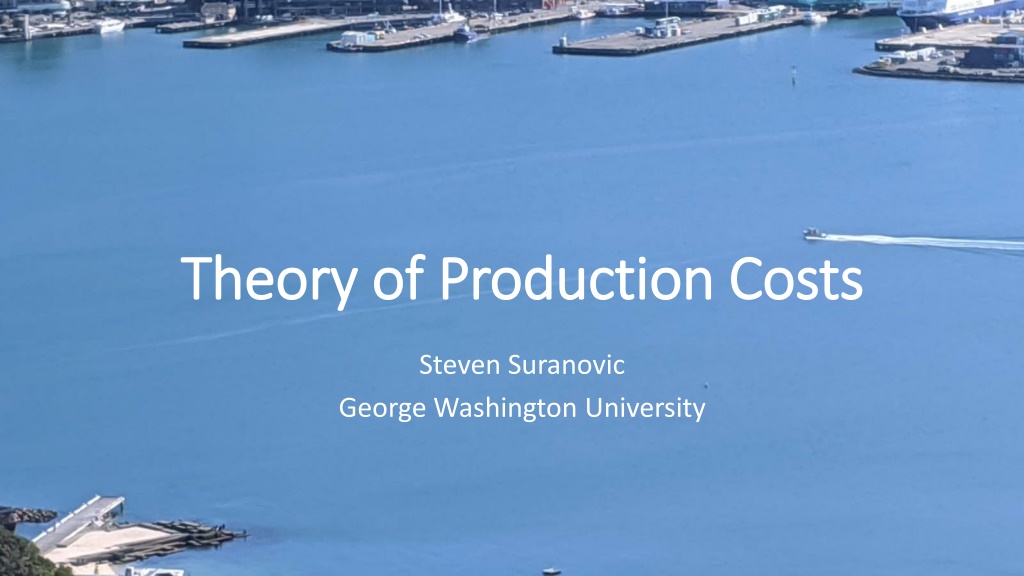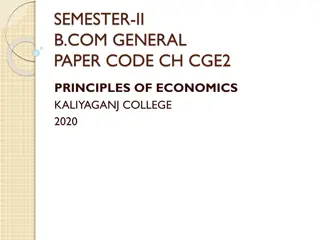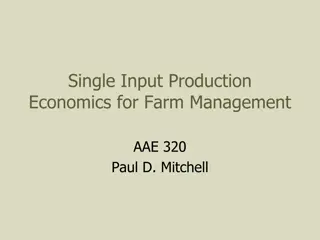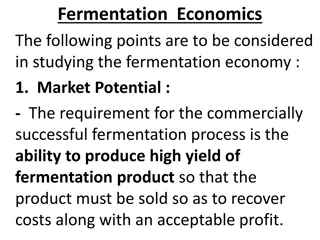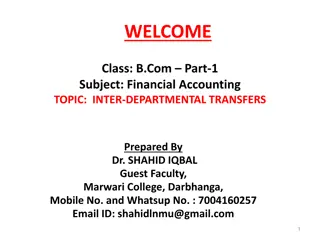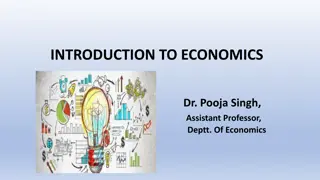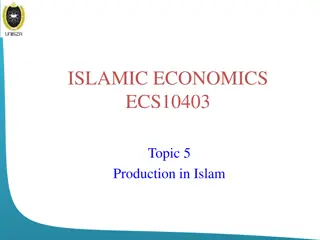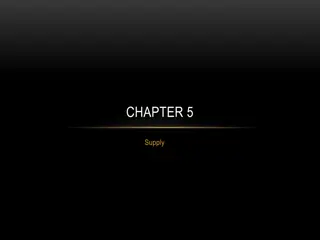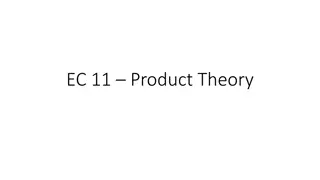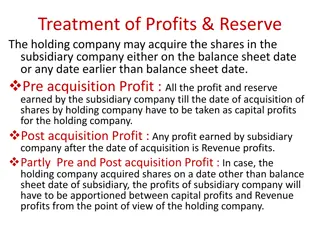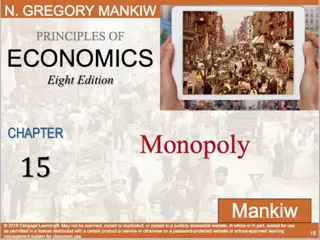Understanding Production Costs and Profits in Economics
Explore the theory of production costs, economic vs. accounting profit, opportunity costs, and more. Delve into key relationships in production economics and see examples contrasting accounting and economic profit. Enhance your knowledge of essential economic concepts.
Download Presentation

Please find below an Image/Link to download the presentation.
The content on the website is provided AS IS for your information and personal use only. It may not be sold, licensed, or shared on other websites without obtaining consent from the author. Download presentation by click this link. If you encounter any issues during the download, it is possible that the publisher has removed the file from their server.
E N D
Presentation Transcript
Theory of Production Costs Theory of Production Costs Steven Suranovic George Washington University
Production Time Lapse : Cruise Shipbuilding Production Time Lapse : Cruise Shipbuilding
Production Time Lapse : Farm to Market Production Time Lapse : Farm to Market
Important Production Relationships Important Production Relationships Accounting vs Economic Profit Increasing vs Decreasing Returns to Scale Fixed vs Variable Costs Economies vs Diseconomies of Scale Average vs Marginal Costs
Economic vs Accounting Profit Economic vs Accounting Profit Profit: = Total Revenue (TR) Total Cost (TC) Accounting Profit includes explicit $ costs only measured costs of labor, rental capital, intermediate goods, etc Economic Profit includes explicit $ costs and opportunity costs
Two Definitions of Opportunity Costs Two Definitions of Opportunity Costs 1) OC1= value of the next best opportunity usually associated with only implicit costs 2) OC2= value of everything that must be given up to produce Including both explicit (labor, capital) and implicit costs
Example: Accounting vs Economic Profit Example: Accounting vs Economic Profit Consider a gift shop sole proprietorship (SP) in a building owned by the SP (no mortgage) Suppose Sales revenue per year = $150,000 Gift shop expenses (immediate goods, electricity, etc) = $80,000 Store Rental (alternative use if not used for gift shop) = $30,000 Alternative best salary for SP = $30,000 Accounting Profit = 150 80 = $70,000 = (salary to SP owner) Economic Profit = 150 80 30 30 = $10,000 (extra salary to SP)
Example: Accounting vs Economic Profit Example: Accounting vs Economic Profit SP salary with Gift shop = $70,000 SP salary with Alternative = 30 + 30 = $60,000 SP maximizes profit/income with gift shop Economic profit maximization guarantees that a firm is producing the good in which it has a comparative advantage making the greatest profit is how to decide what is the best thing to produce subject to the ethical constraints of no force or fraud
Production Concepts: Broom Factory Production Concepts: Broom Factory Consider a Broom factory that uses labor (workers) as the only input Assume production is characterized by increasing returns to scale at low output levels and decreasing returns at higher output levels Assume there are fixed costs in production (FC = $200) Assume hiring workers cost $100 per worker (per day)
Production Schedule: Broom Factory Production Schedule: Broom Factory # of Brooms # of workers
Production Concepts: Broom Factory Production Concepts: Broom Factory Total Product = total output of the good, as a function of labor input Marginal Product of Labor (MPL) = the change in total output given a change in labor input
Production Schedule: Broom Factory Production Schedule: Broom Factory Workers (L) # of workers Output (Q) # of brooms Marginal Product of Labor (MPL = Q/ L) Fixed Cost (FC) Average Fixed Cost (AFC = FC/Q) Variable Cost (VC) Average Variable Cost (AVC = VC/Q) 0 1 2 3 4 5 6 7 0 --- 20 50 90 120 140 150 155
Production Concepts: Broom Factory Production Concepts: Broom Factory Increasing Returns to Scale = the region of production in which the marginal product of labor is increasing Decreasing Returns to Scale = the region of production in which the marginal product is decreasing Constant Returns to Scale = the region of production in which the marginal product is constant, neither increasing or decreasing
Production Schedule: Broom Factory Production Schedule: Broom Factory Workers (L) # of workers Output (Q) # of brooms Marginal Product of Labor (MPL = Q/ L) Fixed Cost (FC) Average Fixed Cost (AFC = FC/Q) Variable Cost (VC) Average Variable Cost (AVC = VC/Q) Decreasing Returns to Scale Increasing Returns to Scale 0 1 2 3 4 5 6 7 0 --- 20 50 90 120 140 150 155
Production Costs: Broom Factory Production Costs: Broom Factory Assume fixed cost of $200 FC = costs that must be paid even with zero output Calculate Average Fixed Cost (AFC) Workers (L) # of workers Output (Q) # of brooms Marginal Product of Labor (MPL = Q/ L) Fixed Cost (FC) ($) Average Fixed Cost (AFC = FC/Q) $/Broom Variable Cost (VC) $ Average Variable Cost (AVC = VC/Q) $/Br $200 200 200 200 200 200 200 200 0 1 2 3 4 5 6 7 0 --- 20 30 40 30 20 10 5 --- 20 50 90 120 140 150 155
Production Costs: Broom Factory Production Costs: Broom Factory Showing Average Fixed Cost (AFC) Note it decreases as output increases, approaching zero Workers (L) # of workers Output (Q) # of brooms Marginal Product of Labor (MPL = Q/ L) Fixed Cost (FC) ($) Average Fixed Cost (AFC = FC/Q) $/Broom Variable Cost (VC) $ Average Variable Cost (AVC = VC/Q) $/Br $200 200 200 200 200 200 200 200 0 1 2 3 4 5 6 7 0 --- 20 30 40 30 20 10 5 --- $10 / Br 4.00 2.22 1.67 1.43 1.33 1.29 20 50 90 120 140 150 155
Production Costs: Broom Factory Production Costs: Broom Factory Assume labor cost of $100 per worker per day Variable cost = production cost of variable inputs, one s that can be fired VC = $100 x # of workers Calculate Average Variable Cost (AVC) Workers (L) # of workers Output (Q) # of brooms Marginal Product of Labor (MPL = Q/ L) Fixed Cost (FC) ($) Average Fixed Cost (AFC = FC/Q) $/Broom Variable Cost (VC) $ Average Variable Cost (AVC = VC/Q) $/Br $200 200 200 200 200 200 200 200 $0 100 200 300 400 500 600 700 0 1 2 3 4 5 6 7 0 --- 20 30 40 30 20 10 5 --- $10 / Br 4.00 2.22 1.67 1.43 1.33 1.29 20 50 90 120 140 150 155
Production Costs: Broom Factory Production Costs: Broom Factory Showing Average Variable Cost (AVC) Note that AVC falls initially, then increases as output rises (U-shaped) Workers (L) # of workers Output (Q) # of brooms Marginal Product of Labor (MPL = Q/ L) Fixed Cost (FC) ($) Average Fixed Cost (AFC = FC/Q) $/Broom Variable Cost (VC) $ Average Variable Cost (AVC = VC/Q) $/Br $200 200 200 200 200 200 200 200 $0 100 200 300 400 500 600 700 0 1 2 3 4 5 6 7 0 --- 20 30 40 30 20 10 5 --- $10 / Br 4.00 2.22 1.67 1.43 1.33 1.29 $5.00 4.00 3.33 3.33 3.57 4.00 4.52 20 50 90 120 140 150 155
Production Costs: Broom Factory Production Costs: Broom Factory Output (Q) # of brooms 0 20 50 90 120 140 150 155 Total Cost (TC = FC + VC) ($) Average Total Cost (ATC = TC/Q) ($) Total Cost = Sum of fixed cost and variable cost at each output level Calculate Average Total Cost (ATC or AC) AC is the cost to produce each unit of the good: unit-cost $200 300 400 500 600 700 800 900 ---
Production Costs: Broom Factory Production Costs: Broom Factory Output (Q) # of brooms 0 20 50 90 120 140 150 155 Total Cost (TC = FC + VC) ($) Average Total Cost (ATC = TC/Q) ($) Showing Average Total Cost (ATC or AC) Note that ATC falls initially = economies of scale then increases as output rises = diseconomies of scale ATC is U-shaped $200 300 400 500 600 700 800 900 --- $15.00 8.00 5.56 5.00 5.00 5.33 5.81
Production Costs: Broom Factory Production Costs: Broom Factory Marginal Cost = Change in Total cost given a change in output level Calculate Marginal Cost (MC) Output (Q) # of brooms 0 20 50 90 120 140 150 155 Total Cost (TC = FC + VC) ($) Average Total Cost (ATC = TC/Q) ($) --- $15.00 8.00 5.56 5.00 5.00 5.33 5.81 Marginal Cost (MC = TC/ Q) $200 300 400 500 600 700 800 900
Production Costs: Broom Factory Production Costs: Broom Factory Showing Marginal Cost (MC) Note that MC falls initially, then increases as output rises (U-shaped) Output (Q) # of brooms 0 20 50 90 120 140 150 155 Total Cost (TC = FC + VC) ($) Average Total Cost (ATC = TC/Q) ($) --- $15.00 8.00 5.56 5.00 5.00 5.33 5.81 Marginal Cost (MC = TC/ Q) --- $200 300 400 500 600 700 800 900 $5.00 3.33 2.50 3.33 5.00 10.00 20.00
Production Costs: Diagram Production Costs: Diagram ATC and MC are the most important MC crosses AC at Min AC Economies of scale falling AC Diseconomies of scale rising AC
Cost Diagrams affected by assumptions Cost Diagrams affected by assumptions Problem Set 3 has four production schedule exercises 1) Fixed costs with Constant Returns to Scale (CRS) 2) No Fixed costs with Constant Returns to Scale 3) No fixed costs with Increasing Returns to Scale (IRS) 4) No fixed costs with Decreasing Returns to Scale (DRS) Lecture) Fixed costs with IRS followed by DRS Note shapes of AC and MC curves under different assumptions
